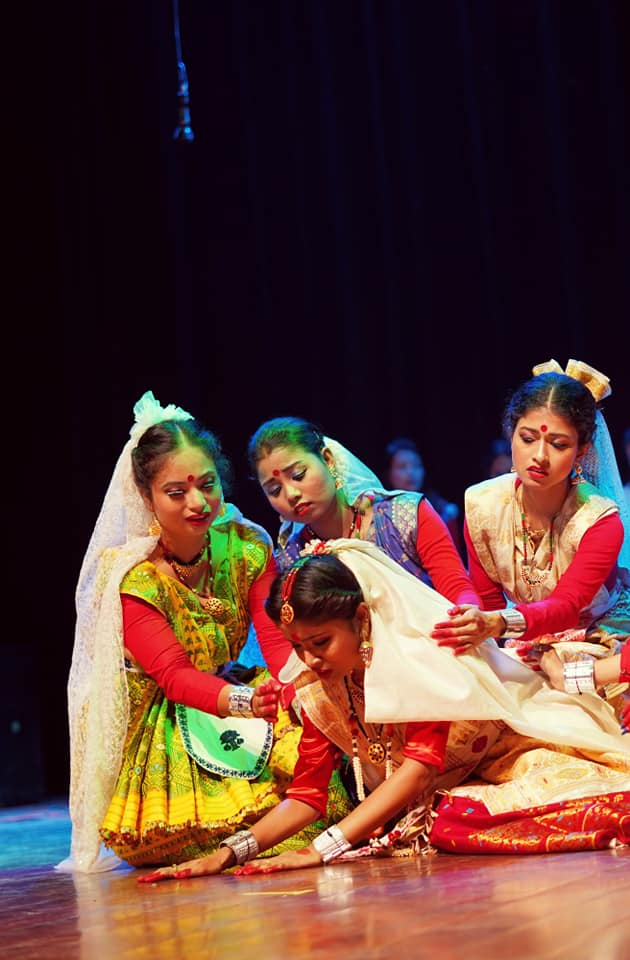Bhaona: Transition and future
By Arup Saikia Bhaona is a traditional form of one-act play of Assam created in sixteenth century by Srimanta Xankardev, which is utilised as audio-visual medium for spreading social and religious reformative message. Originally only staged Ankiya

By Arup Saikia
Bhaona is a traditional form of one-act play of Assam created in sixteenth century by Srimanta Xankardev, which is utilised as audio-visual medium for spreading social and religious reformative message.
Originally only staged Ankiya Nats written by Xankardev and Madhavdev are called Bhaona, more precisely Ankiya Bhaona.
After Xankardev’s demise, his disciples, including Madhavdev to Gopal Ata or Daityari Thakur, haven’t intended to keep Bhaona in strict original ethos. For demand of time and realistic acceptance among common masses, Bhaona was refurbished with new linguistic flavour and story or content. Some formalities of the art form have been shown nominally such as Nandi (benedictory verses) or Mukti Managala (Xutradhar prays for forgiveness of God for any fault at the end) as role of Bhaona. Moreover, changes occurred in language also, instead of Brajavali, prevalent Assamese language of that period adopted to popularise eschewing elite Brajavali language. In ensuing years after 17th century many xatras had been flourished and began to challenge few existing orthodox xatras (monasteries). These xatradhikars (heads of the monasteries) wrote several Bhaona scripts. These devotees of Xankerdev named the plays only written by Xankerdev or Madhavdev as Ankiya Nat. Among new generation, cultural aspects of Bhaona have been emphasised and easy entertainment aspect is more meticulously displayed. Therefore, Bhaona is surviving till present more and less among all classes and castes of Assam.
Bhaona evolved into many forms basing on overall theme or structure of Xankerdev such as Phaujiya Bhaona (started in Cooch Behar), Mukha Bhaona (Bhaona performed wearing mask prevalent in Majuli), Matribhashar Bhaona (Bhaona of assamese mother tongue popular in upper Assam), Baresohoria and Hazari Bhaona (simultaneous performance of many acts under single pandal in the middle of north and south bank of Assam), Dhura Bhaona originated from dhup kirtan of Bengal flourished in Barpeta and Kamalabari monasteries, as such Dhuliya Bhaona, Sabah Bhaona, Juri and Cukraganar Bhaona (without narrators) and many others.
Thanks to easy cultural exchange across the globe and fast development of digital media, taste and outlook of people are changing. Without its pivotal theme, the art form can’t be performed as a medieval drama. Moreover, overlooking modern trends will reduce it to just an act showcasing heritage. The shield to safeguard the rich cultural heritage has to be changed with time. Fruits of these thoughts include popular dimensions, such as English Bhaona under the directorship of Arup Saikia, Gitimallika and Girimallika as joint coordinators. Besides modern Indian languages, from 2018 onwards, Bhaona has been staged in English across the country and abroad. The classical or traditional undertone of the one-act play has been resonated in songs, dialogues, dance and footsteps.
Bhaona is product of composite culture and an unseen thread which unites the people of Assam. It influences Assam very deeply in terms of language, economy and society. New titles such as Gayan-bayan and Pathak, and makeup artists and costume-makers have started existing. Also, mix of eastern Indian languages and Brajavali has decorated the Assamese language with many new words.
Bhaona is displays the broader culture of the northeast. The headgear or pag used in the play is different from one place to other due to local influence. The costume (Ghuri) of Xutradhara could be taken from Ojapali, jackets could be adopted from Tiwa or Mising communities. The Tangali comes from the Bhuyan clan in medieval Assam. For the sake of popular culture, Bhaona has to be contemporary with use of dramatic infrastructure such as decorated proscenium or thrust stage besides the traditional Namghar (Assamese prayer house) or traverse stage. Moreover, mode of expressions, dialogues, lighting, orchestra, language and costumes should have a glimpse of unique beauty surmounting fundamental barrier.
Thus, it is a moral responsibility for people of Assam to sustain the legacy of the indigenous art form with modifications as and when required.
(The author is an alumnus of Delhi University. He is a cultural activist, actor, scriptwriter and poet. He pioneered Bhaona performance in English across the world)


